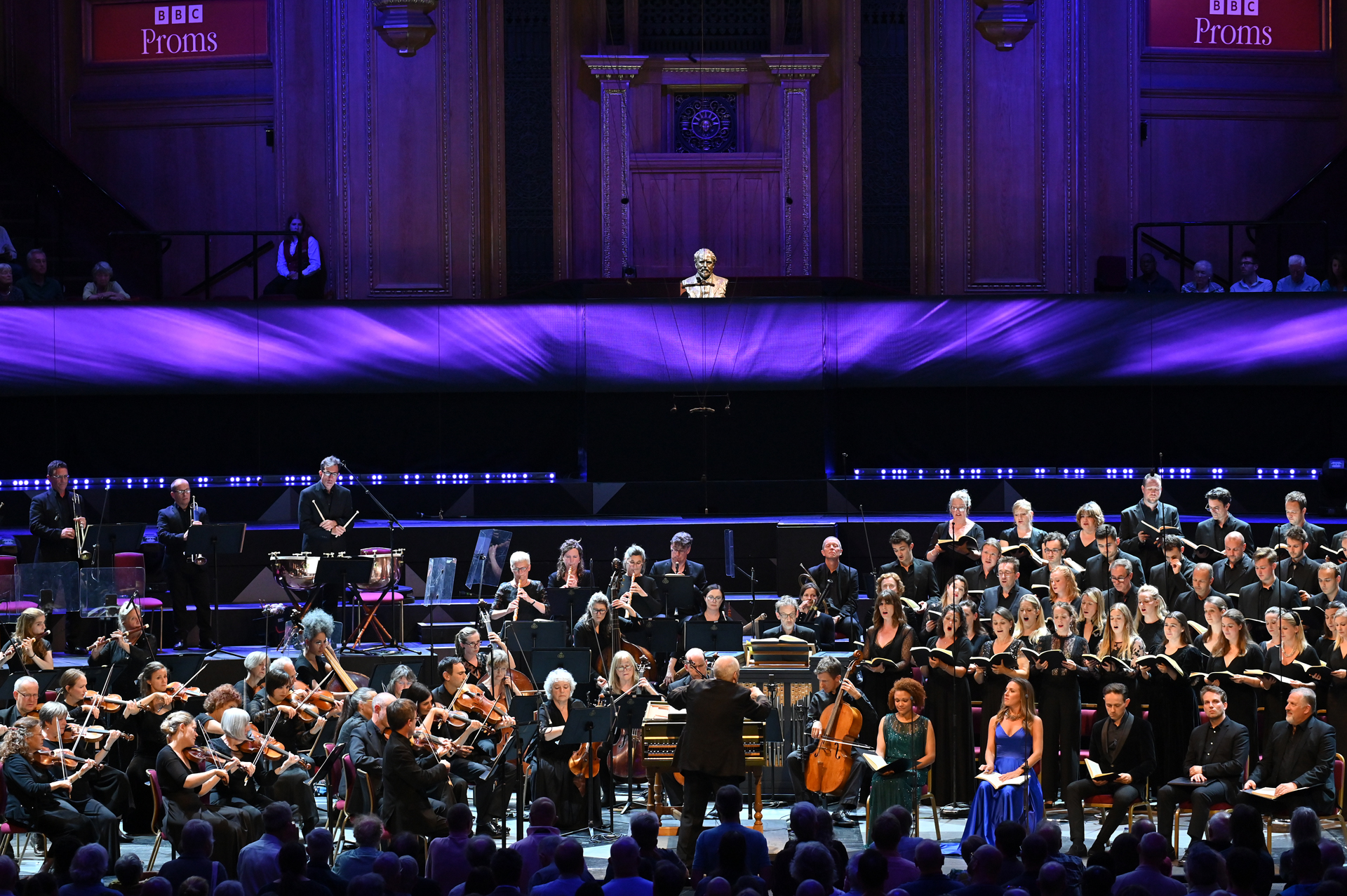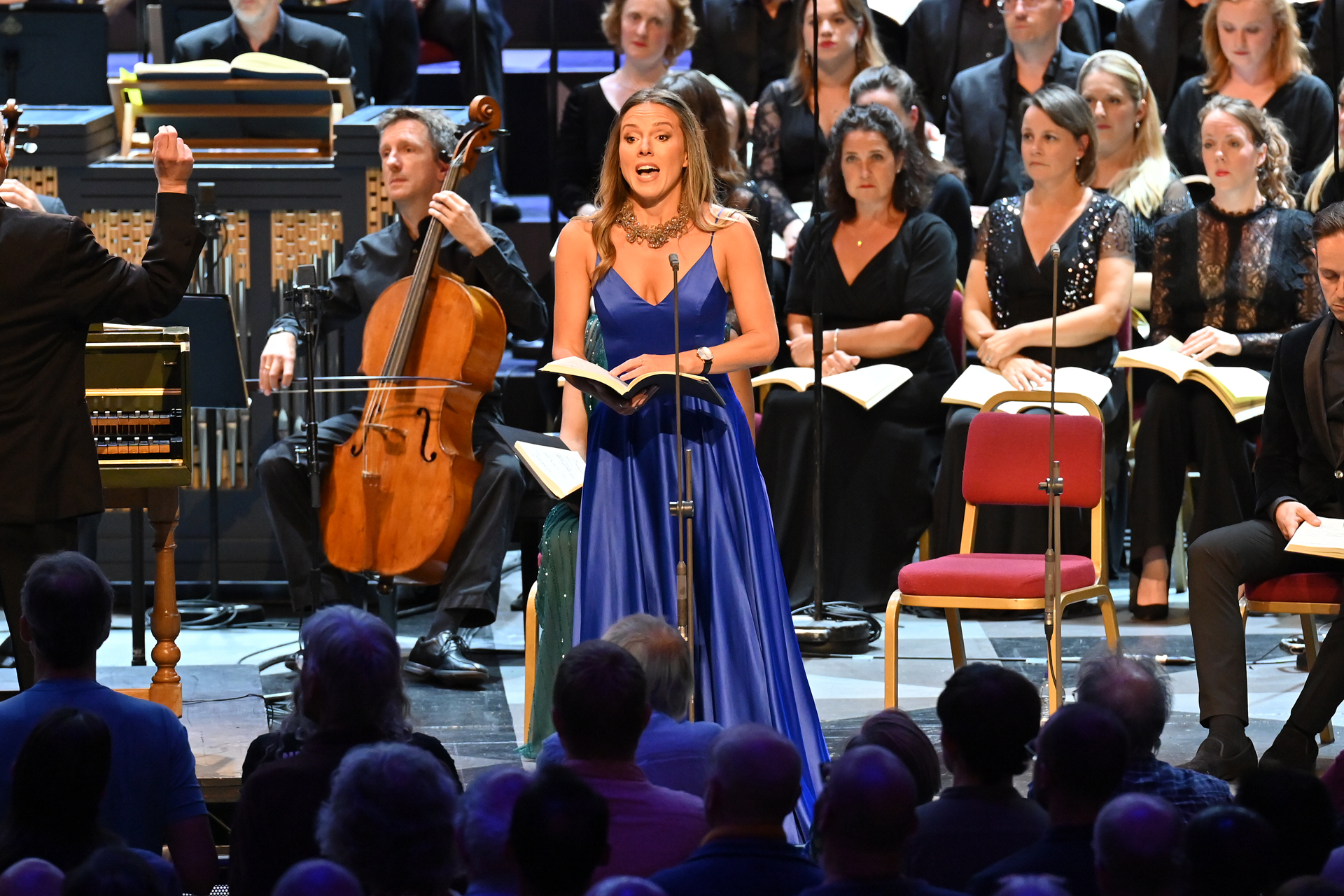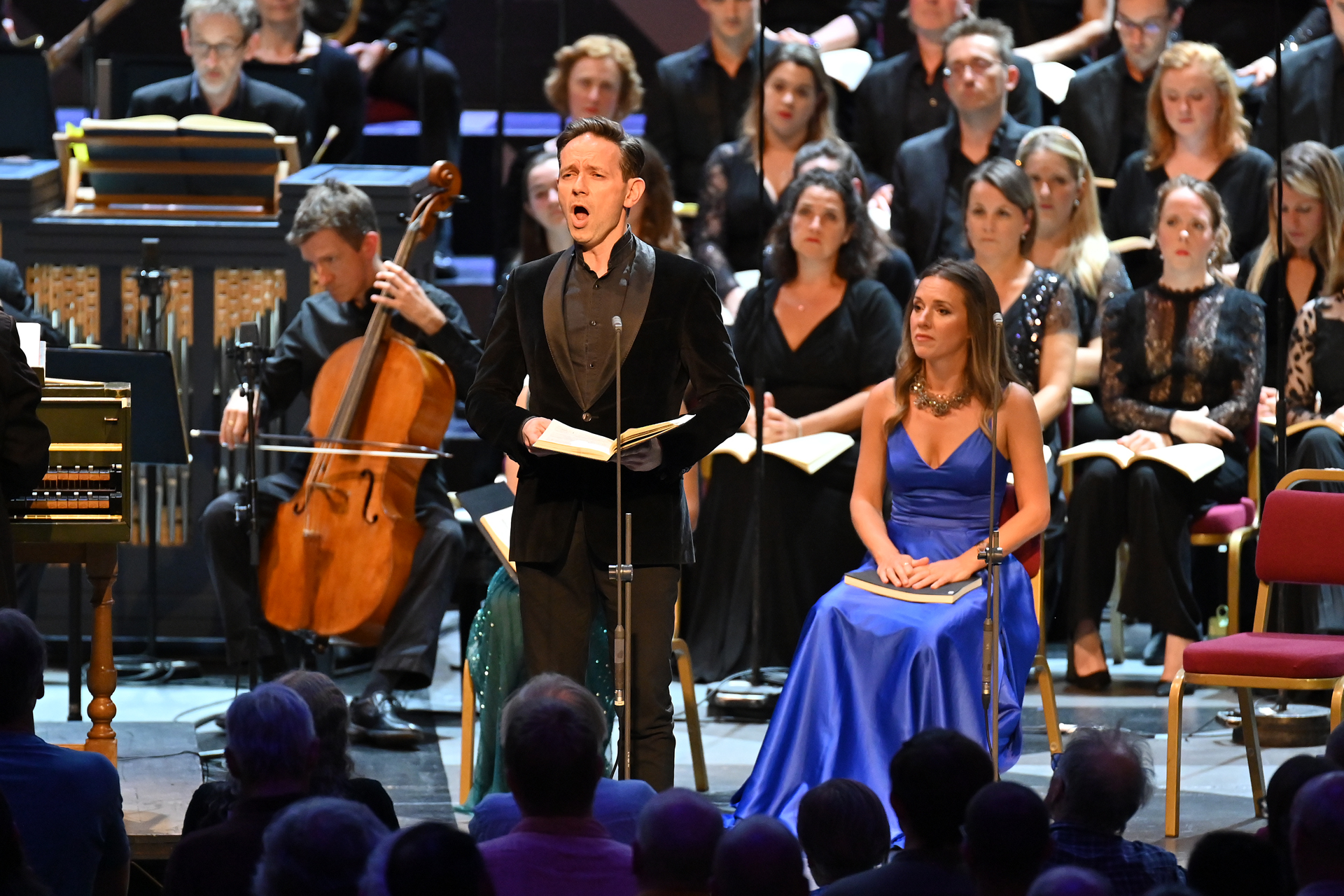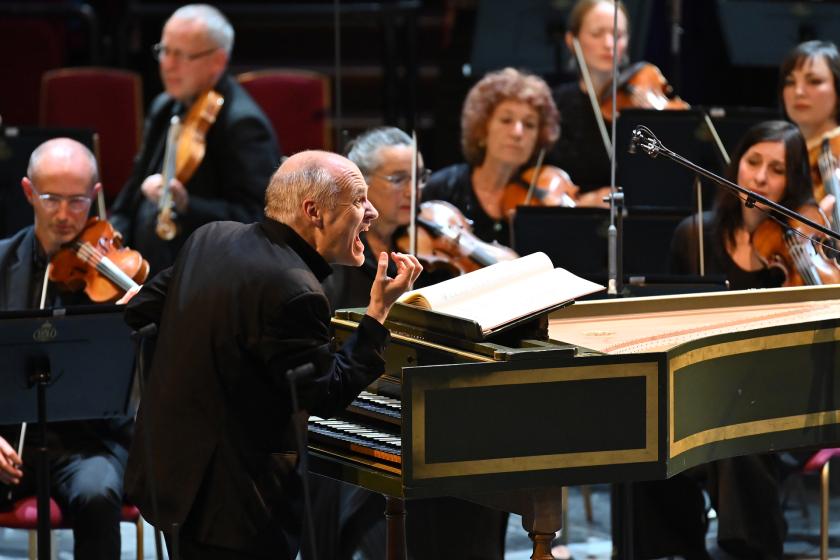A strong team of musical chefs can blend and spice Bach’s mighty Mass in B Minor in a variety of different ways, and still prepare a feast to savour. We don’t know exactly why Bach felt compelled to bundle his decades of genius into this late portmanteau showcase, only that he did – and that its credible interpretations can span contrasting views.
With the Dunedin Ensemble, John Butt has brought both historical rigour and searching musicality to a reading of the work that strips its forces down to a vocal minimum while never stinting on its impact as a whole. However, when Butt directed (from the harpsichord) the Choir and Orchestra of the Age of Enlightenment in his Proms performance of the Mass last night, we enjoyed something of a fusion banquet.  The period-instrument band (pictured above) – its strings clustered on one side with the conductor, but woods and brass widely scattered behind – served up the accents, rhythms and flavours of the finest historically informed menus. Yet the 50-strong choir, angled towards Butt in a way that didn’t always favour every section of the Royal Albert Hall equally, generated a full, rich and almost old-school flavour. This abundance felt far from the pinched austerities of pared-down, academic Bach. It made for a piquant contrast, sometimes even tension. Still, robust and committed singing and playing made sure that the Mass mostly gripped and soared. Only the nerds needed fret about what Bach really meant.
The period-instrument band (pictured above) – its strings clustered on one side with the conductor, but woods and brass widely scattered behind – served up the accents, rhythms and flavours of the finest historically informed menus. Yet the 50-strong choir, angled towards Butt in a way that didn’t always favour every section of the Royal Albert Hall equally, generated a full, rich and almost old-school flavour. This abundance felt far from the pinched austerities of pared-down, academic Bach. It made for a piquant contrast, sometimes even tension. Still, robust and committed singing and playing made sure that the Mass mostly gripped and soared. Only the nerds needed fret about what Bach really meant.
That said, this venue does pose its stiff challenges to any period outfit. At least from my seat, the excellent solo parts – even the piercing trumpets, formidably led by David Blackadder – could sound distant, occasionally frail, whenever the choir moved into the sweet roar of its highest gear. Perhaps the sheer volume of space available didn’t serve the ensemble sound so well. In Bach’s exquisite obbligatos to accompany his arias, voice and instrument sometimes felt too far removed.  Butt began sedately, maybe sluggishly, with a Kyrie that felt muted and subdued. The delicate, even playful soprano duet (Rachel Redmond, pictured below, and Mary Bevan, pictured above) sounded a little underpowered with their Christe eleison, as if both singers were adjusting (as they later did) to the space in front and the forces behind them. And the choir’s sober muscularity hinted at veiled strength, rather than showing their full hand straight away. When the Gloria arrived, with its blaze of trumpets and timpani, the Mass properly took flight.
Butt began sedately, maybe sluggishly, with a Kyrie that felt muted and subdued. The delicate, even playful soprano duet (Rachel Redmond, pictured below, and Mary Bevan, pictured above) sounded a little underpowered with their Christe eleison, as if both singers were adjusting (as they later did) to the space in front and the forces behind them. And the choir’s sober muscularity hinted at veiled strength, rather than showing their full hand straight away. When the Gloria arrived, with its blaze of trumpets and timpani, the Mass properly took flight.
The choir’s Gratias agimus had real heft and silky sheen, while Mary Bevan and the OAE’s splendid leader Huw Daniel made the Laudamus te glow and move in a rapt exchange. In the Domine Deus, a sweet-toned Redmond and mellow tenor Guy Cutting exchanged nicely blended dialogue, while the quartet of fine flutes (led by Lisa Beznosiuk) led the heavenly dance – albeit from a distance.  With the Qui sedes, counter-tenor Iestyn Davies instantly hit his mellifluous yet powerful stride: velvet and steel combined, utterly in control across the range but especially commanding at the faultless top, well supported by Butt’s firmly fluent tempi. Behind the warmly authoritative bass-baritone of Matthew Brook in Quoniam tu solus sanctus, Roger Montgomery’s horn solo proved tender, yearning, wistful – but again, a touch too far away for comfort.
With the Qui sedes, counter-tenor Iestyn Davies instantly hit his mellifluous yet powerful stride: velvet and steel combined, utterly in control across the range but especially commanding at the faultless top, well supported by Butt’s firmly fluent tempi. Behind the warmly authoritative bass-baritone of Matthew Brook in Quoniam tu solus sanctus, Roger Montgomery’s horn solo proved tender, yearning, wistful – but again, a touch too far away for comfort.
The crisp choir entry with Cum Sancto Spiritu showed off Butt’s pinpoint mastery of pace and texture, confirmed over the long haul of the Credo. In the Et incarnatus and Crucifixus, the choir became a many-voiced storyteller – its tale enhanced by sharp dynamic contrasts – as Butt sometimes brought the mood of the Mass close to the brooding, slow-burn drama of the Passions. The trumpet-enriched Et resurrexit leapt into thrillingly new life, and Brook’s Et in Spiritum Sanctum had an ardent serenity that mixed well with Katharina Spreckelsen’s beautifully coloured oboe solo.
Butt slowed the pace, and raised our hopes, with a suspensefully drawn-out Et expecto from the choir, which exited and repositioned for the Sanctus. Often the centrepiece of the Mass, here the movement built its momentum gradually, via long, sweeping lines and an easy, controlled swing. It felt quietly impassioned, if not wholly ecstatic.  As we moved into the Osanna, the radiant assurance of both Cutting (in the Benedictus) and the majestic Davies (pictured above) in the Agnus Dei quelled our doubts. Flutes (hosannas again to Lisa Beznosiuk) and Blackadder’s glittering trumpets no longer sounded at all shy or remote. And Bach’s contrapuntal choral waves, ridden with total precision, broke gloriously across the final Dona nobis pacem. Last week, I heard Simon Rattle prove just what this vast unwieldy cave of sound can achieve, in Mahler’s "Resurrection" symphony. Butt’s Mass confirmed that the hall can threaten to engulf other sorts of work – but that well-led players and singers will be able to master (almost) all its quirks. Still, I would love to have heard these forces, and this approach, in a cosy church – even in some modestly-dimensioned cathedral, echo and all.
As we moved into the Osanna, the radiant assurance of both Cutting (in the Benedictus) and the majestic Davies (pictured above) in the Agnus Dei quelled our doubts. Flutes (hosannas again to Lisa Beznosiuk) and Blackadder’s glittering trumpets no longer sounded at all shy or remote. And Bach’s contrapuntal choral waves, ridden with total precision, broke gloriously across the final Dona nobis pacem. Last week, I heard Simon Rattle prove just what this vast unwieldy cave of sound can achieve, in Mahler’s "Resurrection" symphony. Butt’s Mass confirmed that the hall can threaten to engulf other sorts of work – but that well-led players and singers will be able to master (almost) all its quirks. Still, I would love to have heard these forces, and this approach, in a cosy church – even in some modestly-dimensioned cathedral, echo and all.














Add comment